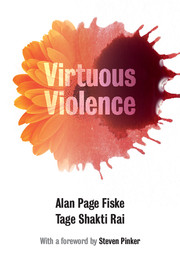Book contents
- Frontmatter
- Dedication
- Contents
- Figures and tables
- Foreword
- Warm thanks
- The point
- 1 Why are people violent?
- 2 Violence is morally motivated to regulate social relationships
- 3 Defense, punishment, and vengeance
- 4 The right and obligation of parents, police, kings, and gods to violently enforce their authority
- 5 Contests of violence: fighting for respect and solidarity
- 6 Honor and shame
- 7 War
- 8 Violence to obey, honor, and connect with the gods
- 9 On relational morality: what are its boundaries, what guides it, and how is it computed?
- 10 The prevailing wisdom
- 11 Intimate partner violence
- 12 Rape
- 13 Making them one with us: initiation, clitoridectomy, infibulation, circumcision, and castration
- 14 Torture
- 15 Homicide: he had it coming
- 16 Ethnic violence and genocide
- Chapter 17 Self-harm and suicide
- 18 Violent bereavement
- 19 Non-bodily violence: robbery
- 20 The specific form of violence for constituting each relational model
- 21 Why do people use violence to constitute their social relationships, rather than using some other medium?
- 22 Metarelational models that inhibit or provide alternatives to violence
- 23 How do we end violence?
- 24 Evolutionary, philosophical, legal, psychological, and research implications
- The dénouement
- References
- Index
20 - The specific form of violence for constituting each relational model
Published online by Cambridge University Press: 05 December 2014
- Frontmatter
- Dedication
- Contents
- Figures and tables
- Foreword
- Warm thanks
- The point
- 1 Why are people violent?
- 2 Violence is morally motivated to regulate social relationships
- 3 Defense, punishment, and vengeance
- 4 The right and obligation of parents, police, kings, and gods to violently enforce their authority
- 5 Contests of violence: fighting for respect and solidarity
- 6 Honor and shame
- 7 War
- 8 Violence to obey, honor, and connect with the gods
- 9 On relational morality: what are its boundaries, what guides it, and how is it computed?
- 10 The prevailing wisdom
- 11 Intimate partner violence
- 12 Rape
- 13 Making them one with us: initiation, clitoridectomy, infibulation, circumcision, and castration
- 14 Torture
- 15 Homicide: he had it coming
- 16 Ethnic violence and genocide
- Chapter 17 Self-harm and suicide
- 18 Violent bereavement
- 19 Non-bodily violence: robbery
- 20 The specific form of violence for constituting each relational model
- 21 Why do people use violence to constitute their social relationships, rather than using some other medium?
- 22 Metarelational models that inhibit or provide alternatives to violence
- 23 How do we end violence?
- 24 Evolutionary, philosophical, legal, psychological, and research implications
- The dénouement
- References
- Index
Summary
People violently constitute relationships though circumcision and excision, brutal initiations, killing rivals to the throne, proving loyalty to a superior by killing someone who threatens him, and human sacrifice. People enhance their own relationships with their deities by extreme asceticism, flagellation, or amputating a digit as an offering; others facilitate a vision of their personal companion spirit by hanging themselves by hooks through their chest muscles. The conduct or performance of many relationships consists of organized, socially instituted violence such as boxing and mixed martial arts, ice-hockey checking and football tackling, or combat among warriors who fight for glory. Redressive and terminative violence in response to transgressions of social relationships includes all sorts of corporal and capital punishment: burning witches, killing adulterers, eye-for-an-eye vengeance and feuding, killing men who insult one’s honor, and honor suicide by those who have failed to do their duty. Redressive violence is ubiquitous, ranging from dueling to resolve a dishonor, judicial combat to determine guilt, lynching those perceived as disrespectful, beating wives perceived as having failed to be sufficiently dutiful, attacking husbands who are disrespectful jerks, terrorist bombing, and targeted killing by drones. Sometimes violence is intended to enforce a relationship by forestalling transgression – for example, by terrorizing subjects or slaves into submission. Torturing heretics and enemies falls somewhere in between redress and enforcement, as do violent self-defense and killing intruders. In honor cultures, killing a dishonored sister, daughter, or cousin terminates an intolerable relationship, cleansing the stain and thereby restoring the family honor. Innumerable cultures conduct, or used to conduct, trial by ordeal – for example, adjudicating witchcraft guilt by submerging the accused to see if she drowns, making her hold a hot iron to see if it burns her, or giving her poison to see if she dies. The atomic bombing of Hiroshima and Nagasaki was morally motivated violence on a mass scale, motivated by MP proportionality cost and benefit computations aimed to reduce American casualties in the most efficient way. The most massive moral violence practices in history were twentieth-century ethnic cleansings, acts of “purifying the race” or the nation, where the removal or killing of persons construed to “pollute” the shared essence of a “people” was motivated by the feeling that “mixture” or “mongrelization” is evil, unnatural, disgusting, dishonorable, and dangerous.
- Type
- Chapter
- Information
- Virtuous ViolenceHurting and Killing to Create, Sustain, End, and Honor Social Relationships, pp. 251 - 257Publisher: Cambridge University PressPrint publication year: 2014

